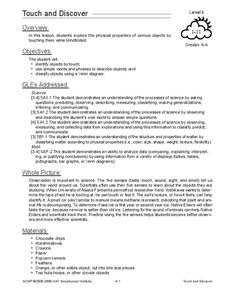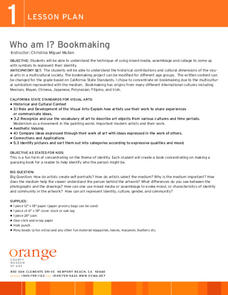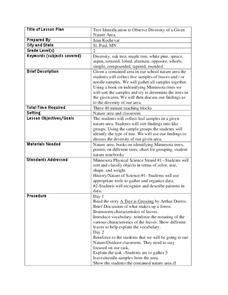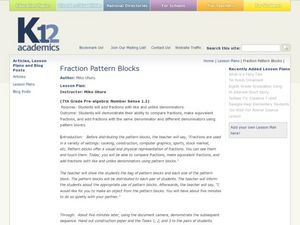Curated OER
Classification and Attributes
Learners classify objects based on their attributes. They explain how archaeologists use classification to help answer research questions.
Curated OER
The Strongest Shape
Learners work collaboratively to design and construct a roof out of Legos for a house that was built in a previous lesson. The roof must be structurally sound and pass certain criteria determined by the teacher.
One Billion
Math, Age 3-5
Jump start children's math education with this fun basic skills resource. Offering dozens of different touch-and-swipe activities with colorful graphics, this program is perfect for all young learners.
Center for Learning in Action
Introduction to the States of Matter
Liquids, gases, and solids are the states of matter in which scholars investigate in a lesson plan that offers in-depth information and engaging activities that look into the three states and the changes their properties make when mixed...
Curated OER
Rock vs. Mineral - Lesson #1
Students describe visual, textural, and other physical qualities of sample rock specimens. Using compare and contrast skills, students sort and classify the specimens according to their assessments of the qualities present in each....
Curated OER
Solids in the Playground
First graders locate and identify solids in the schoolyard. In this geometric solids lesson, 1st graders locate two solids on the playground. They work as a group to compare and contrast them according to shape, texture, weight, size,...
Curated OER
Science- Unit on Matter- Liquids-
Second graders discover that everything is made of matter. they determine the properties of liquids and that like solids, liquids can be grouped or classified according to properties or qualities. they assess that solids have a definite...
Curated OER
Problem Solving
Second graders practice problem solving strategies. In this problem solving lesson, 2nd graders use strategies such as guess and check, acting out, drawing pictures and looking for patterns to solve problems. Students work in groups to...
Curated OER
Tree Talk
Learners discuss trees, leaves, and the growth process For this 1st - 3rd grade lesson plan, students identify various types of leaves, recognizing the differences in size and shape. Learners create tracings of various leaves to...
Curated OER
Polymer
Students investigate polymers by completing 3 experiments. In this polymer lesson plan, students mix plastic with acetone, they create polyurethane foam, they make slime and build a polymer model once their polyurethane foam is set. ...
Curated OER
Biodiversity
Students investigate the diversity of temperate forests and tropical rainforests. They catch and observe local insects, sort leaves and insects on a chart, listen to the book "A Walk in the Rainforest," and create a class bar graph that...
Curated OER
Ramps
Students experiment to see how various objects roll down ramps. In this ramp lesson, students observe weight, size, and material of objects. Students compare speeds by using a second ramp.
Curated OER
The Red Badge of Courage: A New Kind of Realism
Sudents compare specific excerpts from The Red Badge of Courage to first-hand accounts of Civil War battles, in text and images and list elements of Crane's style in The Red Badge of Courage that contribute to its realism.
Curated OER
Auroras
In this auroras activity, students read 2 descriptions written about a massive solar storm that occurred in 1859. Students read each description and compare the specific points in each. They create a time line of the events that occurred...
Curated OER
Touch and Discover
Students identify the physical properties of items using the sense of touch. In this touch and discover lesson, students describe items. Students sort items using a Venn diagram.
EngageNY
Describing Distributions Using the Mean and MAD
What city has the most consistent temperatures? Pupils use the mean and mean absolute deviation to describe various data sets including the average temperature in several cities. The 10th lesson in the 22-part series asks learners to...
Inside Mathematics
Conference Tables
Pupils analyze a pattern of conference tables to determine the number of tables needed and the number of people that can be seated for a given size. Individuals develop general formulas for the two growing number patterns and...
Curated OER
Tiling the Plane
Fifth graders use pattern blocks and triagular grid paper to reivew shape names, be introduced to the concept of a tiling of the plane, and determine which pattern blocks tile the plane. They are asked if they comprehend what a...
Curated OER
Who am I? Bookmaking
Students explore the process of bookmaking that has its origins from many different international cultures. The multicultural symbolism represented by the medium is utilized by students to expres their identity.
Curated OER
Spider Anatomy Lesson: Is It a Spider?
Students review information on a website which shows different types of spiders. They sort images of spiders from other insects. They create their own spider out of materials and share them with their classmates.
Curated OER
Tree Identification to Observe Diversity of a Given Nature Area
In this tree identification lesson plan, 2nd graders read A Tree is Growing, discuss what makes up a forest, brainstorm characteristics of leaves, gather samples of leaves and examine their samples. Students will sort leaves and compare...
Curated OER
Investigating Quadrilaterals
Fourth graders discuss the various attributes of quadrilaterals. In groups, they use the attributes to sort quadrilaterals into different classes and a hierarchy. They review the new vocabulary and attributes with a partner to end the...
Curated OER
Making a Rock Collection, Lesson 1
Students discover the different shapes and sizes of rocks. They create a chart on what they already know about rocks and sort rocks by size. They place cutouts of rocks on construction paper from smallest to largest.
Curated OER
Fraction Pattern Blocks
Seventh graders practice using pattern blocks. In this pre-algebra lesson, 7th graders complete tasks that require them to compare fractions, make fractions equivalent, and add fractions.























